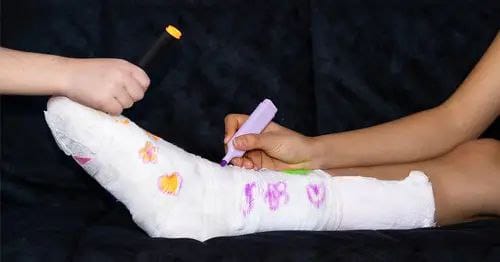Steps you can take to protect your young athlete
We all know that nutrition is important for your child’s growth and development. But your child’s growth — particularly height — also depends on bone growth plates.
When those growth plates become damaged through a sports-related injury or accident, they not only can be painful but also can affect how well and how long your child’s arms, legs, hands and feet grow.
What is a growth plate?
Growth plates are thin cartilage discs at the end of long bones in children and adolescents.
As the cartilage cells in the discs multiply, the bones grow longer
Growth plates continue to lengthen bones until about age 14 in girls and age 16 in boys. In both genders, the surge of estrogen at puberty causes growth plate cartilage to change into solid bone.
Growth plates disappear when the skeleton reaches maturity and the bones stop growing. However, bones can stop growing earlier — stunting physical development and causing functional problems — if the growth plates become severely damaged.
How growth plates get damaged
Growth plate injuries happen in a similar fashion to broken bones. They can be caused by:
- Trauma such as a fall or collision: About 30% of growth plate injuries are from playing contact sports, such as football, soccer and basketball. Another 20% are due to recreational activities, such as skateboarding and skiing. The remaining 50% are from general accidents.
- Overuse: Little League shoulder is one example. Chronic stress on the shoulder from too much ball-throwing causes microdamage to the growth plate. Pain and swelling result. Similar damage can occur in gymnasts’ wrists as well as the body of any young athlete involved in repetitive training.
When a limb becomes stressed in some way, it breaks wherever it’s weakest. Cartilage is weaker than bone, so in children, injuries can be more common in the growth plate.
How to detect growth plate damage
If your child complains of pain in the shoulder or joints, don’t decide that there is no injury because your child can wiggle their fingers or toes or there is no swelling or bruising. Those signs aren’t reliable indicators.
The most reliable sign of a growth plate injury is tenderness at a single point
It may not hurt anywhere outside that point. And it might not look like anything is wrong.
Other indicators include:
- Inability to continue activity due to pain.
- Change in performance.
- A deformed limb.
If there’s a growth plate injury, doctors can treat it with casts or splints.
Casts or splints keeps the limb immobile so it can heal better. If a bone is out of alignment, we may need to perform surgery to reposition it and possibly keep the bone growing.
3 ways to prevent growth plate injuries
You may not be able to prevent growth plate injuries, but you and your child can take precautions. Dr. Ballock recommends these three:
- Don’t play one sport year-round. Kids need at least three months off from their chosen sport to allow growth plate microdamage to heal. It’s also wise to change physical activities for a few months each year to work other muscle groups.
- Use protective equipment. Recommended gear will vary by sport, but it’s also important for recreational activities. For example, wrist guards may help prevent injuries in skateboarders.
- Avoid risky recreational activities. Jumping on a trampoline is a common risky activity, especially if more than one child is on the trampoline, and accounts for many bone fractures in children.
No matter how it happens, if you suspect your child has injured a growth plate, it’s time to make a doctor’s appointment for an evaluation.





